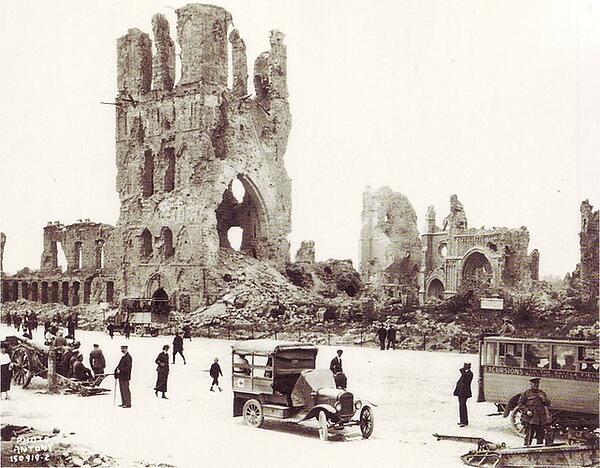Ypres and World War One
Ypres was a renowned medieval town that once thrived on a strong textile trade. However, during World War One, it became better known as a hub for the destruction, trench warfare, poison gases and death that are linked to the war.
While the Germans had managed to advance quickly though Belgium (the Schlieffen Plan), they failed to take the Ypres Salient and it was in this area where the battles of Ypres and Passchendaele took place. The once thriving town was almost entirely destroyed, and what stands today was largely rebuilt after the war.

While Ypres had been well-fortified in the 17th Century, changes in society had meant that many of these defences were rendered redundant by the time the war began. As such, German troops (from the 3rd Reiter Division) advancing through Belgium on 13th October 1914 had no problem entering Ypres. They held the town’s Burgomaster to ransom and took 75,000 Belgian Francs.
The following day, the British Expeditionary Force entered Ypres and the Germans quickly withdrew. The hands remained in Allied hands for the remainder of the war. However, the Germans could not allow the Allies to maintain such a strong hold on the area and continued to advance north and south of the Ypres Salient.
On 22nd November 1915, the Germans began their first counter-attack, starting an artillery bombardment against the town and destroying much of the medieval town. Many civilians died in the attack, and the majority of the few who survived went to the comparatively safe nearby town of Poperinge.
Between April and May 1915, the Germans undertook a second artillery barrage against the town and destroyed the 1260 Cloth Hall as well as the historic Collegiate Church of St. Martin. On 9th May, military commanders made the decision to evacuate all remaining civilians from the town, and from this date on the town was left to the military for the remainder of the war.
The year 1916 was a quieter year for the town, but the Third Battle of Ypres in 1917 reignited the warfare in the area. By 1918, as a result of a spring offensive, the German forces made it to the outskirts of the town. However, they were held back by British forces and remained in Allied hands until the Germans eventually withdrew in September 1918.
While many of the town’s buildings with rebuilt after the war, arguably the most important was the Menin Gate. The gate covers the route that tens of thousands of men would have taken as they moved to the front line, making the gate and the lion that sits atop it a fitting tribute to those who lost their lives in and around Ypres.
MLA Citation/Reference
"Ypres and World War One". HistoryLearning.com. 2026. Web.
